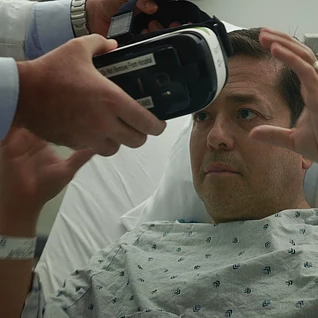Is it Feasible to Use VR in a Hospital?

For decades, inpatient health care providers have recognized that patient management does not merely entail acute symptom management; hospitalized patients may also experience anxiety, uncertainty, and boredom exacerbated by a radical change in living environment and loss of customary rights and privileges. In order to care for the whole patient, hospitalists must consider not only the biological impact of illness, but also the psychosocial impact. However, the dynamic nature of hospital medicine, coupled with limited time to spend with individual patients, pose challenges to offering holistic inpatient care.
Recent advances in virtual reality (VR) technology offer a compelling opportunity to address inpatient biopsychosocial distress. VR devices provide immersive, realistic, three-dimensional experiences that “transport” users to novel environments. Thus, VR has potential to alleviate negative aspects of hospitalization by providing multisensory information and allowing patients to “escape” to pleasant locations and realities.
Improvements in software and hardware design, as well as associated cost reductions, have made VR promising for widespread use in health care. However, the practicality and qualitative experiences of using VR at scale in the general acute hospital setting has not been formally evaluated. Because the hospital environment poses unique challenges that outpatient clinics or rehabilitation units do not, it is important to understand the “real-world” practicality of using VR in hospitalized patients—this is a necessary first step before pursuing more extensive evaluation of VR on inpatient outcomes and resource utilization.
Thus, we assessed the eligibility, usability, and acceptability of VR equipment and software in a diverse cohort of hospitalized patients in Cedars-Sinai Medical Center: an urban, community-based, academic hospital in Los Angeles.
In our study, we found two overarching and somewhat contradictory results. First, we found that despite evaluating 510 inpatients for VR, only 30 (5.9%) were both eligible and willing to experience the technology. Strict application of exclusion criteria, including presence of motion sickness, stroke, seizure, dementia, nausea, and isolation status, rendered 82.9% of participants immediately ineligible. Of the remaining eligible patients, 66% refused to participate for a variety of reasons, including anxiety about the technology and high levels of illness severity. In short, despite seeking to apply VR to a cohort, only a small number of patients were ultimately able and willing to participate. Future research should evaluate patient knowledge, attitudes, and beliefs about VR in the hospital, and enumerate specific reasons why some patients are unwilling to use VR.
Second, among participants, most patients found VR to be a positive and pleasant experience. Patients described how VR could ease anxiety, reduce pain through distraction, and provide an “escape” from the confines and boredom of the hospital room. These qualitative results were further supported by endorsement of most participants that they would use VR again if given the opportunity. Common reasons for enjoying the experience were distraction, immersion, being away from the hospital, doing something beyond their means or ability, and the novelty of the experience. In this manner, VR may support the unmet need for patients to virtually “escape” the hospital environment and achieve some degree of normalcy.
Similar to other evolving digital technologies, we found that patients willing to try VR were significantly younger than those who refused. Older individuals can have more difficulty than younger individuals in adopting new technologies—a term described as the “digital divide” that results from variations in self-efficacy and confidence with technology. However, although older patients were more hesitant to participate in this VR study, they tended to be less critical of the technology than younger patients were, and most participants enjoyed the experience, independent of age. Based on this observation, encouraging older patients to use VR may offer benefits to some individuals even if there is initial hesitancy to use the technology.
Although most patients described benefits of using VR, there were important limitations identified as well. The goggles were frequently described as too heavy, hard to fit, uncomfortable, and difficult to focus. In addition, because the VR goggles were considered a medical device by our institutional review board, they required meticulous cleaning between patients, application of fresh liners for each use, and provision of a head cap to minimize infection risk. These technical shortcomings may limit the scalability of VR in the hospital and provide opportunities to improve the form factor of current devices. Optimally, a disposable device, such as Google Cardboard goggles or Homido clip-on goggles, could be used to minimize infection risk and logistical concerns, although the current disposable goggles do not yet provide the same immersive experience as higher-end sets.
The notion of a “Virtualist Consult Service” that offers tailored VR experiences for hospitalized patient is appealing. However, to realize this vision, several intermediate steps will be necessary. Based on our study, we believe that next steps should be to test different goggle sets and form factors, evaluate longer video experiences, offer VR directly through primary providers, and evaluate the impact of VR on both patient reported outcomes (eg, pain, satisfaction scores) and objective outcomes (eg, vital signs). If VR is shown to be pragmatic, scalable, and effective, then we should evaluate its cost-effectiveness and budget impact by monitoring resource utilization (eg, pain medication), length of stay, and readmissions. Our group at Cedars-Sinai is undertaking this research now and will report more results as they become available.
June 27, 2016



